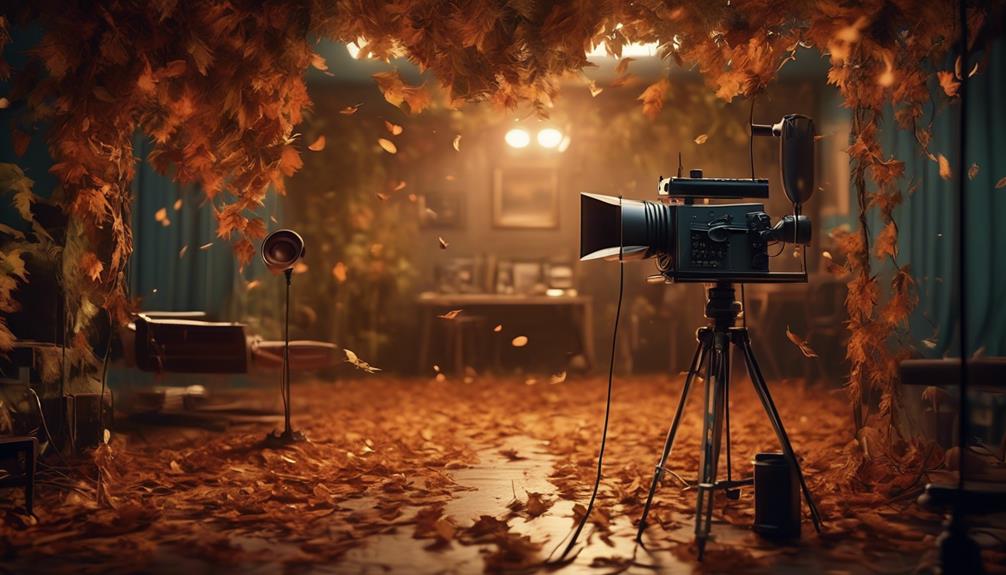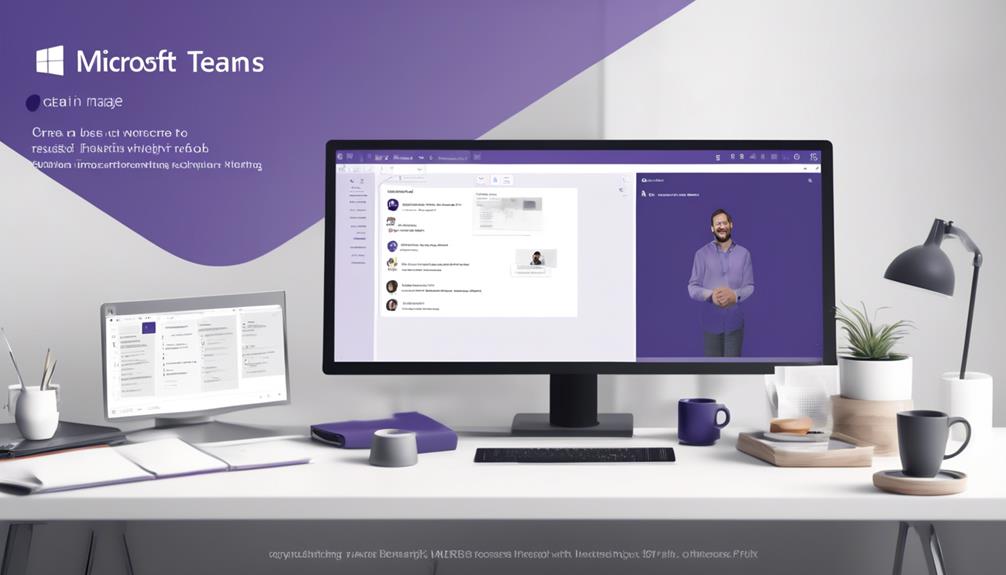Ambient sound in filmmaking contributes to around 50-70% of the total audio experience in a film. It is a critical element that is frequently overlooked, but it significantly influences how the audience perceives and engages with a movie.
From the subtle rustling of leaves to the distant hum of traffic, ambient sound plays a vital role in creating a realistic and immersive environment for the viewer.
But what exactly is ambient sound, and how does it contribute to the overall storytelling of a film? Let's explore the significance of ambient sound in filmmaking and how it helps to shape the mood and atmosphere of a scene.
Key Takeaways
- Ambient sound accounts for a significant portion of the overall audio experience in a film, ranging from 50-70%.
- Capturing ambient sound requires the use of specific equipment, such as shotgun or parabolic microphones, along with portable audio recorders with high-resolution capabilities.
- Ambient sound plays a crucial role in setting the mood and atmosphere of a scene, both indoors and outdoors.
- Utilizing ambient sound effectively can enhance storytelling by creating a sense of place and immersing the viewer in the film's world.
Importance of Ambient Sound in Filmmaking
Ambient sound plays a crucial role in filmmaking by adding realism and depth to a scene, enhancing the audience's immersion in the story. It's the subtle background noise that we mightn't even notice consciously, but it's there, making the setting come alive. Imagine a bustling city street, a quiet forest, or a busy café. These ambient sounds contribute to the overall audio experience, creating a cohesive storytelling experience. They're like the paint on a canvas, adding layers and texture to the visuals.
What's fascinating is that ambient sounds vary based on indoor and outdoor settings, reflecting the expected noises of a location. For indoor scenes, it might include the hum of air conditioning or the creaking of floorboards. Outdoors, it could be the chirping of birds or the rustling of leaves. These sounds help the audience connect to the setting on a subconscious level.
In filmmaking, ambient sounds are often recorded separately and added to the final audio mix as a separate track. This allows for more control and precision in creating the desired auditory atmosphere. However, unwanted ambient sounds can disrupt the audio quality and overall experience of a scene, highlighting the importance of capturing and controlling these sounds during filming.
Techniques for Capturing Ambient Sound

Capturing ambient sound effectively requires using appropriate microphones and recording equipment to ensure high-quality audio. When employing techniques for capturing ambient sound in filmmaking, the following points are crucial:
- Selecting the Right Equipment
- Utilize high-quality microphones suitable for capturing ambient sound with precision, such as shotgun or parabolic microphones, to ensure clear and accurate recordings.
- Employ portable audio recorders or field recorders equipped with high-resolution audio capabilities to capture ambient sound with fidelity and detail.
- Use windshields and shock mounts to minimize unwanted noise interference and ensure the purity of the ambient sound recorded.
- Strategic Location Selection
- Identify and utilize locations that align with the desired ambient sound, ensuring minimal unwanted background noise during recording to maintain the purity and authenticity of the ambient audio.
- Consider the acoustic properties of the environment to capture ambient sound effectively, adjusting microphone placement and recording settings accordingly.
- Utilize soundproofing materials or techniques when recording in controlled environments to minimize external interference and capture pristine ambient sound.
- Experimenting with Techniques
- Explore various microphone techniques, such as stereo and surround sound recording, to capture immersive ambient audio and enhance the auditory experience in the film.
- Implement proper gain staging and monitoring practices to capture ambient sound at optimal levels while avoiding clipping or distortion, ensuring the integrity of the recorded audio.
- Consider employing binaural recording techniques to capture spatial and 3D audio, adding depth and realism to the ambient sound in the filmmaking process.
Role of Ambient Sound in Setting the Mood
After mastering the techniques for capturing ambient sound, we can now explore how ambient sound plays a crucial role in setting the mood for a film. Ambient sound, also known as background sound, is the foundation upon which the entire sonic landscape of a film is built. It creates an immersive experience, transporting the audience to the depicted location and enhancing the visual storytelling. Whether it's the bustling noise of a city street or the serene chirping of birds in a forest, ambience sound helps to establish the atmosphere and realism of a scene.
Indoor ambient sounds, such as the clinking of silverware and murmurs in a restaurant, can make the audience feel as if they're right there in the bustling eatery. Outdoor ambient sounds, like the crashing waves on a beach or the rustling of leaves in a forest, not only add depth to the setting but also evoke specific emotions associated with those environments. These sounds are recorded to enhance the sense of place and provide a sonic backdrop that complements the visuals.
Additionally, unwanted ambient sounds, such as plane noise, can disrupt the intended mood of a scene and may require careful editing in post-production. Overall, ambient sound serves as a powerful tool in shaping the mood and atmosphere of a film, making it an indispensable element in the filmmaking process.
Utilizing Ambient Sound to Enhance Storytelling

Enhancing storytelling through the use of ambient sound effects can significantly elevate the emotional impact and immersive quality of a film. This is achieved by integrating ambient sounds that reflect the background noises in a particular scene or location, effectively creating the illusion of a specific place or setting.
When incorporating indoor ambient sounds, such as the clanging of dishes in a restaurant scene, the viewer is enveloped in an immersive experience that enhances the storytelling.
Similarly, outdoor ambient sounds, like crashing waves on a beach, not only provide a sense of place but also contribute to the visual storytelling, enriching the overall narrative.
It's important to note that unwanted ambient sounds, such as plane noise, can disrupt the audio quality and may need to be excluded or edited in post-production to maintain the integrity of the storytelling.
Creating Realism With Ambient Sound
Creating a sense of realism in filmmaking through ambient sound is essential for engaging the audience and enhancing the overall viewing experience. Ambient sounds, whether indoors or outdoors, play a crucial role in creating a compelling and realistic audio experience. By incorporating ambient sounds, filmmakers can transport viewers into the world they have created, making the scenes more immersive and believable.
To illustrate the impact of ambient sounds, let's consider the following table:
| Type of Ambient Sound | Description | Example |
|---|---|---|
| Indoor | Reflect expected noises, like clanging dishes | Restaurant background chatter |
| Outdoor | Establish a sense of place, like crashing waves | Forest birds chirping |
| Unwanted | Disrupt audio quality and may need editing | Plane noise requiring post-production |
Frequently Asked Questions
What Is an Example of an Ambient Sound?
In a natural environment, an example of ambient sound includes background noise like waves crashing, wind blowing, and seagulls chirping, creating a rich sound atmosphere.
This audio environment sets the scene and adds depth to the visuals. These natural sounds are crucial for creating an immersive experience and capturing the essence of a specific location.
What Is the Purpose of Ambient Sound?
Ambient sound is vital in filmmaking. It's crucial for creating an immersive experience and enhancing storytelling through atmosphere. This importance can't be overstated.
The ambient sounds transport the audience to the depicted environment, making them feel like part of the story. It's an art form that demands precision and creativity, as every sound contributes to the overall immersion and impact of the film.
What Is the Ambient Sound in a Video?
Ambient sound in a video creates the backdrop for storytelling, adding depth and atmosphere to the scene. It encompasses the background noise captured during audio recording, which enhances the overall sound design. Whether it's the natural sounds of a location or specific sound effects, ambient sound is crucial in film production.
However, unwanted ambient sounds may require post-production editing to maintain audio quality.
What Is the Difference Between Room Tone and Ambient Sound?
In filmmaking, room tone and ambient sound serve distinct purposes.
Room tone is the sound of a location without movement or dialogue, crucial for seamless dialogue scenes.
Meanwhile, ambient sound captures the environment's presence, enhancing the film's atmosphere.
Both are essential in sound design, providing background noise for location recording.
Understanding the difference between them is crucial for mastering the art of capturing and utilizing ambient sounds in filmmaking.
Conclusion
So, as we can see, ambient sound in filmmaking is like the seasoning in a delicious dish, adding depth and flavor to the overall experience.
It helps to transport the audience into the world of the film, creating a more immersive and engaging viewing experience.
By capturing and utilizing ambient sound effectively, filmmakers can enhance storytelling, set the mood, and create a sense of realism that captivates the audience from start to finish.










